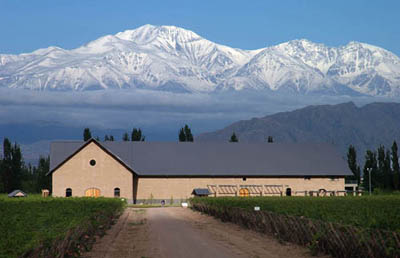Dr Vino's wine blog
wine talk that goes down easy
Ed Lehrman, Susana Balbo’s American importer
With Susana on vacation this month, I thought we could hear from her American importer, Vine Connections. Partner Ed Lehrman spoke to me from his office in Sausalito last week.
 When Ed Lehrman goes to Mendoza, he stays in a hotel for half the normal tourist price. How? He lets one of his local producers make the hotel bookings for him. That’s one of the tricks of the trade Ed has learned over the past five years as he has established his company as one of the strongest importers of Argentine wines to the US.
When Ed Lehrman goes to Mendoza, he stays in a hotel for half the normal tourist price. How? He lets one of his local producers make the hotel bookings for him. That’s one of the tricks of the trade Ed has learned over the past five years as he has established his company as one of the strongest importers of Argentine wines to the US.
In 1999, Ed went on a fateful journey to Argentina. He had just sold his wine retail business and decided to join one of his distributors, Nick Ramkowsky, on a trip to South America. Although they only spent five days in Argentina and neither spoke much Spanish, they were so impressed by what they saw and tasted that they decided to go into business together and start importing the wines of Argentina to the US.
Ed tasted 3,000 wines a year in his retail business, a company for mail order wine, and Nick tasted a lot too. But when they were sampling in Mendoza, “He looked at me and I looked at him, and we agreed that this is far different from wines we know as Argentine—we have to do something about this,” Ed recalled on the phone last week from his office in Sausalito, CA.
“Susana’s wines were the ones that made the biggest mark. Here was a very talented wine maker whose wines weren’t being exported.”
“Argentina in late 1990s was similar to Napa in late 1970s since people were just developing a sense of their own brands and what they had to achieve. They still are today. Really only since 1994 have they been making quality wines for export,” Ed said.
It was a hard time to make quality wine at all. There wasn’t much domestic demand for it despite the fact that Argentina has one of the highest per capita consumption rates in the world. “The Argentine consumer doesn’t have tradition of paying up. Susana stuck to high quality. Thus the benefit for her was to go to the export market and show what she can do,” Ed said.
With their knowledge of the US market and its quirks, as well as packaging and sales, Ed and Nick set up Vine Connections and started importing the wines of Argentina. Armed with color printouts of their labels, and samples of their 12 wines, they started knocking on doors to set up a distributor network from scratch. They met with tremendous enthusiasm and acceptance even though the wines were priced aggressively for a relatively unknown country starting at $22 for the BenMarco Malbec and going up to $50 retail. “Price points weren’t as tough as they are today,” Ed said.
Today VineConnections has a presence in 45 states. His portfolio of wines now is almost entirely dedicated to the wines of Argentina since Ed says that as an importer “it is increasingly difficult to be a generalist.” The Vine Connections portfolio also includes the wines of Ernesto and Laura Catena, Tikal and Luca respectively, both the children of Argentine wine pioneer, Nicolas Catena. And they are also importers of several dozen premium sakes from Japan.
 Ed describes Dominio del Plata, the winery that Susana built with her husband Pedro, as more comfortable and homey than other, more luxurious wineries. They built it right among their vineyards and also included a residential space in the winery so from their dining room windows, you can see the fermentation tanks. And it’s location on the way to the pass through the Andes to Chile, makes it very convenient. It’s small wonder that one thing on Susana’s plate for the next year is thinking how to better handle tourism requests.
Ed describes Dominio del Plata, the winery that Susana built with her husband Pedro, as more comfortable and homey than other, more luxurious wineries. They built it right among their vineyards and also included a residential space in the winery so from their dining room windows, you can see the fermentation tanks. And it’s location on the way to the pass through the Andes to Chile, makes it very convenient. It’s small wonder that one thing on Susana’s plate for the next year is thinking how to better handle tourism requests.
Single vineyard wines are more risky in Argentina than they are in other parts of the wine world because of the risk of a snap hail storm, which can decimate a crop in 15 minutes. He cited staggering figures of a 13% annual loss rate of the total Mendoza grape crop over the last 20 years. Thus producers tend to source their grapes from several growing sites to diversify the risk. And they also resort to hail netting and even cannons, whose blasts are thought to break up hail squalls.
Despite this hail risk, which is manageable, Ed does not envy his fellow wine importers who import wines from France and Italy. “From a business standpoint, I’m not sure I would want to face the vagaries of the weather. The climate in Mendoza is similar to California. There certainly is vintage variation. Overall if you look at the consistency and quality you can achieve, it is great. We thought about the downside and there was very little.”
 Snow, of all natural factors, has played a role in their business recently. To ship their wines to the US, Ed and Nick use the port of San Antonio, Chile. Getting there from Mendoza, trucks laden with the wine of Susana and their other producers must bypass Aconcagua, the highest mountain in the Western Hempisphere, and scale the Uspallata pass at 12,500 feet. In the summer, climbing this height takes only a few tanks of gas but is no great obstacle. However, now, when it is winter down under, it has become a bottleneck.
Snow, of all natural factors, has played a role in their business recently. To ship their wines to the US, Ed and Nick use the port of San Antonio, Chile. Getting there from Mendoza, trucks laden with the wine of Susana and their other producers must bypass Aconcagua, the highest mountain in the Western Hempisphere, and scale the Uspallata pass at 12,500 feet. In the summer, climbing this height takes only a few tanks of gas but is no great obstacle. However, now, when it is winter down under, it has become a bottleneck.
“It’s been hard to even find containers to fill,” Ed laments because the traffic has been so backed up this winter because of the tremendous snowfall. Normally, the pass can close for a day or two in the winter but this winter it has been closed for up to two weeks at a time. Nonetheless, ships departing every two weeks means that they don’t have to wait for a boat once they clear the Andes.
Once the wines arrive in the US, the Vine Connections team is on the road selling the wines. Ed says that he travels less than Nick since he has two children but he is still on the road about 100 days a year. Nick has been shouldering as many as 280 days a year on the road, though he will be pulling back with the hiring of new sales staff bringing their national total up to seven. It’s important for Ed and Nick that their sales staff feel the same enthusiasm for Argentina that they do so all of the staff have been there to experience it first-hand.
Ed and Nick were drawn to Argentina in 1999 by the wines but in 2002 many others were drawn by the currency collapse. “When we went from the first time, we thought we had found the Holy Grail, to make good wine consistently, and we thought we could have the place to ourselves for quite a while. But now Argentina is so much on the map and the number of foreigners who have moved in has been phenomenal. No major wine growing country is without some sort of presence,” Ed said. “I’m stunned that it took the world this long to find out.”
Gregory Smolik, in Campania
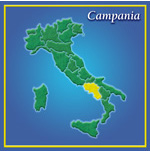 Greg recently spent some time in the “red zone” of Mt. Vesuvius peering into the original crater. No, he wasn’t leading an excavation of Pompeii. Instead, he was walking the vineyards of winemaker Gabriele DeFalco.
Greg recently spent some time in the “red zone” of Mt. Vesuvius peering into the original crater. No, he wasn’t leading an excavation of Pompeii. Instead, he was walking the vineyards of winemaker Gabriele DeFalco.
Located in Campania, above the Bay of Naples and on the flanks of Mt. Vesuvius, DeFalco is one of four wine producers in Greg’s Sauvage Selections portfolio. DeFalco, the former vineyard manager of the critically acclaimed Feudi di San Gregorio, makes both red and white wines from the Lacryma Christi del Vesuvio DOC.
This trip to see DeFalco was particularly fun for Greg since his wife Nell was able to tag along. This week-long trip, primarily to go to a family wedding but also to see DeFalco, was the first one that Nell went on since Greg started the business. “Usually he’s so booked with appointments, driving eight hours a day, and racing around without a day of rest—that it doesn’t make for a vacation at all,” Nell wrote me last week.
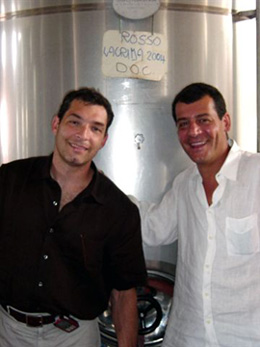 “It’s great to be able to visit the wineries with Nell,” Greg told me on the phone from the O’Hare international terminal. “Obviously the hardest thing about being on the road is being without her but since she helps me with the catalogue writing and images, I always love it when she can come with me to get a sense of the place herself.” Sampling the fresh regional foods together can’t be bad either as they shared a meal of sardines, two different types of clams, mussels, and local aliche with DeFalco overlooking the bay.
“It’s great to be able to visit the wineries with Nell,” Greg told me on the phone from the O’Hare international terminal. “Obviously the hardest thing about being on the road is being without her but since she helps me with the catalogue writing and images, I always love it when she can come with me to get a sense of the place herself.” Sampling the fresh regional foods together can’t be bad either as they shared a meal of sardines, two different types of clams, mussels, and local aliche with DeFalco overlooking the bay.
DeFalco left Feudi to pursue his own authentic winemaking style Greg said. Although Feudi is known for having put the local, indigenous varietals such as the white Falanghina and the red Aglianico on the wine world’s radar screen (Robert Parker gave Feudi’s $65 Serpico 2001 Aglianico 98 points), when they turned to pursue a winemaking style that produced bigger, more oak-driven wines DeFalco no longer felt comfortable. Now Greg buys most of the wine that he makes for export to the US.
“The Feudi white (Falanghina) does not have a sense of place. The DeFalco white is lighter and has notes of peach that go great with fish. The Feudi rocks the fish,” Greg summarized.
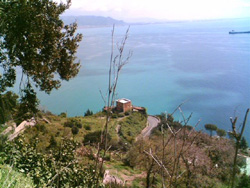 American consumers will be able to taste more of the wines this year. Greg said that the DeFalco labels had gotten final approval from the US authorities, which meant that a container of their wines could now ship. “Hopefully we can get a container out of Italy in the next couple of weeks before the country shuts down for August. Then it would arrive here in Chicago in October and be available for the holidays,” Greg eagerly reported.
American consumers will be able to taste more of the wines this year. Greg said that the DeFalco labels had gotten final approval from the US authorities, which meant that a container of their wines could now ship. “Hopefully we can get a container out of Italy in the next couple of weeks before the country shuts down for August. Then it would arrive here in Chicago in October and be available for the holidays,” Greg eagerly reported.
Consumers will await them with baited breath—and tongues. Ten days after his return, Greg led consumers through a tasting dinner of DeFalco wines. At the recently opened Night Café in Arlington Heights, IL, Greg had them taste the white, and they approved. Then Greg had them try an olive or take a bit of salt on their tongues and then taste the wines again. “Everybody said ‘holy crap! I had no idea that food could do that to a wine!'”
DeFalco might be the producer closest to Smolik if in name only since his mother’s maiden name is DeFalco. Although he family came from Sicily, where the spelling is DiFalco, they switched to the Campania spelling of DeFalco for ease of pronunciation in America. Greg grew up speaking Italian with his mother and visiting her relatives in Sicily every summer.
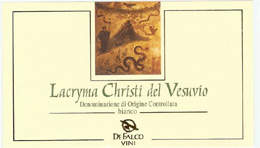 Greg was headed to Sicily on Friday when I reached him at O’Hare. He’s going to be in Italy working on a new, complimentary business. He has just gotten financing for a new line of wines that he is going to import under the Cantina della Passione name. They will be accessible selections of barbera, chianti, and Pinot Grigio with a focus on quality. “I have restaurant owners telling me ‘I’ll never be able to sell Aglianico Bianco in the suburbs, Greg.’ So this new line is wine is for them: quality, accessible and higher volumes.”
Greg was headed to Sicily on Friday when I reached him at O’Hare. He’s going to be in Italy working on a new, complimentary business. He has just gotten financing for a new line of wines that he is going to import under the Cantina della Passione name. They will be accessible selections of barbera, chianti, and Pinot Grigio with a focus on quality. “I have restaurant owners telling me ‘I’ll never be able to sell Aglianico Bianco in the suburbs, Greg.’ So this new line is wine is for them: quality, accessible and higher volumes.”
“I’ve never felt so liberated in my life. I can do esoteric stuff with Sauvage Selections. Then I can also have mainstream wines in other line,” Greg cheerfully stated as they called his flight over the loudspeaker.
Gregory Smolik, importing artisanal wines of Italy
 Gregory Smolik has taken the plunge. In January 2004, at age 36, he left Sam’s Wines and Spirits, the large Chicago wine retailer, and went off on his own to import artisanal wines from Italy. He’s still in the start-up phase of his new life as a wine importer but his chances of success are good given his background, his philosophy, and ultimately, his wines. In the year ahead, Greg aims to add more producers and more US states that carry his wines.
Gregory Smolik has taken the plunge. In January 2004, at age 36, he left Sam’s Wines and Spirits, the large Chicago wine retailer, and went off on his own to import artisanal wines from Italy. He’s still in the start-up phase of his new life as a wine importer but his chances of success are good given his background, his philosophy, and ultimately, his wines. In the year ahead, Greg aims to add more producers and more US states that carry his wines.
During his six years as Italian wine buyer at Sam’s Greg presided over one of the largest selections of Italian wine under one roof. Sam’s had one 25,000 square foot store on the north side of Chicago with about 9,500 different wines in stock when Greg left (they have added a suburban location since then), so this is no corner shop. Greg built the Italian wine portfolio from 350 wines to about 2000 through several buying trips to Italy.
Greg was most excited about introducing new wines to consumers. He found many small scale producers in Italy, arranged to have them imported and sold at Sam’s. Some of these wines are no longer around but others have grown to multi-million dollars in sales.
Having visited numerous wineries, talked with hundreds of producers and sold wine to legions of customers, the transition to importer was an easy one. Greg knew what kind of wines he wanted to have in his portfolio and what kinds of labels would appeal to American consumers. “I didn’t want to have corporate wine that says ‘made in Italy’ but could really have been made anywhere. I care about where wine comes from, not a tank or a barrel. I have a story to tell and there’s a lot of passion behind that story,” Greg told me on the phone last week.
Fans of the big and oaky wines known as “super Tuscans” will be disappointed as rustic authenticity best summarizes what Greg looks for in a wine. He only works with family-run wineries in four regions of Italy: Lombardy, Campania, Basilicata, and Calabria. One of his producers, Cabanon is biodynamic. “I seek wines with the least amount of altering of the grape and the soil.” He describes his wines as “clean but expressive.” The wines in his portfolio retail in the $7 -$25 price range. Amazingly, he imports only about 1,200 cases of wine a year from four producers, but is looking to scale up.
An amateur musician, Greg also says that he is artistic and enjoys designing labels. But the bureaucratic side can be frustrating, as label approvals from the government authorities can take months. “I’m just starting out and can’t afford lawyers to rush them through,” he laments. “Label approval alone gives me gray hair.”
His wines are mainly available in Chicago, but he has recently picked up distribution in Nevada and Wisconsin. (Greg sells his wines to distributors who then sell them to retailers. His Illinois distributor, Maverick, has provided financial backing for him as well as a sales team.) Given his view that Chicago is “the most competitive wine market in the country,” he has cut his teeth on the hardest location and laid a good base for his expansion. He plans to add a dozen states over the next year including New York, Florida and Texas.
He is a passionate cook and the only thing he likes better than finding the right wine is finding the right food. The crisp white Falanghina paired with greens sautéed in garlic and olive oil, the fruity red Aglianico with the salt of veal—these are pairings that elevate the food and the wine, and drive him to keep finding good wines.
His wines have appeared not only in the leading shops in Chicago but also in some leading restaurants. Alinea, a cutting-edge new restaurant from chef Grant Achatz with a 25 course tasting menu, has included Greg’s I Portali wine with the squab. “A perfect match,” Greg declares with satisfaction.
In the next year, I look forward to seeing Greg in action, as he sells his wines, talking with him about logistics and labels, the financial side of the importing, and how he finds new producers for his portfolio. He’s off to Sicily and Campania for a week so we’ll check in with him when he gets back. Stay tuned!
What would you like to know about Greg? Send in your questions.
Greg currently has no website. That’s something on his plate for the near future.
> 6/30: Question from Terry in New York
I am fascinated with Greg Smolik’s venture, as I am now writing for the Italian wine blog Aristide and plan to help the owner of the blog do an English-language version based here in NYC. My main question for Greg (now): where does he think the US market for vitigni autoctoni (indigenous Italian varieties) will be in 5 years?
> 7/1: Greg’s reply
(Great timing for this question) What’s happening is a resurgence and/or a realization that good old fashioned wholesome quality can not only be attainable but that consumers are becoming more educated and particular in food AND wine especially in the U.S. where there is the drive to be authentic. Statistics prove that Americans love to travel especially to Italy and take as much of it in as they can, Appreciation for the culture, the uniqueness of the wines and confidence in themselves as far as pairing food and wine are all ways that can help me describe why I think indigenous wines will prosper in the next five years. I see indigenous or traditional flavors in wines catching up to all the great chefs who have been making food this way for some time, after all its not the presentation its the quality that goes into food and wine that makes someone come back, but I’m being wordy, I don’t think these types of wines will double in the next five years due to the fact that there are just so many Italian wines out there also there are too many financially powerful, over-marketed wines that leave the market bloated but I do believe that they have certainly taken root and will prove themselves as people are understanding more and more about the nuances and the essence of tradition, culture and genuinity.
Susana Balbo, making wine in Mendoza
It was 25 degrees (-6C) in Mendoza on the morning that I reached Susana Balbo by phone last week. Nestled in the foothills of the Andes, the vineyard was dotted with workers pruning the vines down to stumps she said. But the winery itself was in its annual hibernation as the grapes were harvested two months ago and the wines were quietly fermenting.
Although she and her husband, Pedro Marchevsky, started making their own wines in 1999, it wasn’t until 2001 that their striking winery, Dominio del Plata, which Susana designed, opened for making her three lines of wines. The wines include Malbec, Argentina’s signature grape, as well as more unusual offerings including Syrah-Bonarda, a rosé from Malbec, and the white Torrontés. They range from about $10 to $35 retail in the US and can be found in 17 countries.
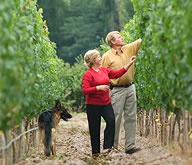 Export markets have been essential for Susana since the concept stage of the winery. Her first winery, a short-lived venture in the early nineties, targeted the large domestic market in Argentina. Since then, exporting has become not only easier but essential. For example, when the Argentine peso collapsed in 2002 losing 75 percent of its value against the dollar, wineries with strong exports profiles actually saw their sales rise in peso terms (see my backgrounder).
Export markets have been essential for Susana since the concept stage of the winery. Her first winery, a short-lived venture in the early nineties, targeted the large domestic market in Argentina. Since then, exporting has become not only easier but essential. For example, when the Argentine peso collapsed in 2002 losing 75 percent of its value against the dollar, wineries with strong exports profiles actually saw their sales rise in peso terms (see my backgrounder).
A graduate in enology in 1981, Susana honed her winemaking skills during nine years in the Cafayate province. She returned to Mendoza in 1990 and refined her export skills as export manager during the mid-to-late nineties at Catena, one of the locomotives of the Argentine wine industry. She also designed the new Catena winery, a useful base for later designing her own. And she also met her husband there, since Pedro was the long-time vineyard manager at Catena, and the two were married in 1995. But they both left Catena to pursue their own winery together.
Susana is careful to draw on her experience at Catena but not the contacts that she made there. Her American exporter, Vine Connections, is a different importer than Catena’s American importer, an important point for Susana. She also maintains different importers in Europe than Catena. “All professionals want their own boats, to be their own captain,” she says.
The popularity of the wines abroad is having ramifications at home. In one way, Susana is starting to see more demand from the domestic market. As Argentines travel abroad again now that the economy is on a firmer footing, they are seeing her wines overseas and then come home and look for them. Further, foreign consumers are increasingly traveling to Argentina and the winery gets many calls for visits, but can hardly accommodate any of them. That’s something that Susana would like to work on more in the next year.
She also aims to do more experimentation in the vineyard. The 25 acres of vines are managed according to sustainable agriculture practices. But the real wild card in grape growing in Mendoza is the risk of hail storms that can erupt without warning just before harvest time, pound the plump grapes, and leave the vineyard owner with no crop. Thus Susana is trying strategic placements of nets of various colors and densities.
The winery is a family affair with Susana making the wines, while Pedro and his son manage the vineyards. Pedro’s daughter-in-law is an artist and designs all the labels. Susana’s son is currently a student at the University of California at Davis, the premier school for winemaking and viticulture in the US. One of the wines is called “Crios,” which means offspring and the label depicts two small hands in a big one symbolizing Susana and her two (now grown) children.
Susana is headed to Davis to visit her son and then take some time relaxing on the beach in northern Brazil. We’ll check in with her American importer next month. Over the coming year, I’ll talk with Susana more about the making and selling of wine and hopefully meet up with her in Argentina or America to see her doing one of the two.
Welcome to The Real Wine World
June 29, 2005
What does it take to be a wine producer? Or an importer? Or a retailer? Discover the inside scoop through “a year in the life of” three accomplished wine industry professionals. In this space, we will track one year of making and selling wine in three different parts of the world and watch how they do their business and overcome challenges.

 From Argentina, Susana Balbo brings 25 years of winemaking experience to her wines in Mendoza. She and her husband, Pedro Marchevsky, the vineyard manager, started their winery in 1999. The practice sustainable agriculture and export 90 percent of their wines to 17 countries. The winery is currently running near its capacity so how the manage their production, and the increasing number of tourists the wines attract, are key challenges for the coming year.
From Argentina, Susana Balbo brings 25 years of winemaking experience to her wines in Mendoza. She and her husband, Pedro Marchevsky, the vineyard manager, started their winery in 1999. The practice sustainable agriculture and export 90 percent of their wines to 17 countries. The winery is currently running near its capacity so how the manage their production, and the increasing number of tourists the wines attract, are key challenges for the coming year.
Susana Balbo, Making wine in Mendoza 6/29/05
 In America, Gergory Smolik started his own wine importing company in Chicago in January 2004. He imports wines from four regions of Italy all from family-run wineries that produce only limited amounts of wine each year. Smolik believes in rustic authenticity. Prior to starting his own business, Greg was the Italian wine buyer for six years at Sam’s Wines in Chicago. In the coming year, he expects to grow his list of producing wineries and expand the availabillity of his wines in the US.
In America, Gergory Smolik started his own wine importing company in Chicago in January 2004. He imports wines from four regions of Italy all from family-run wineries that produce only limited amounts of wine each year. Smolik believes in rustic authenticity. Prior to starting his own business, Greg was the Italian wine buyer for six years at Sam’s Wines in Chicago. In the coming year, he expects to grow his list of producing wineries and expand the availabillity of his wines in the US.
Gregory Smolik, Importing artisanal wines from Italy 6/29/05

Big Nose, Full Body is a wine shop in the Park Slope area of Brooklyn, NY. The shop is celebrating its fifth anniversary this year; Patricia Savoie, the current owner, purchased the shop two years ago. Since then it has won various accolades as well as a loyal following in the neighborhood. The small, smart shop stocks around 350 wines from around the world mainly in the $8 – $15 price range. With wines from off the beaten path places such as Turkey and California Charbono, Pat says “we have good breadth, not depth” to describe her store’s offering.
In Paris, at Winevolution
I am at the Winevolution trade conference in Paris…Very interesting panels but limited time to post. Until I get a chance to post about some of the activities, feel free to scan the program at winevolution.org. Back soon.
US growing, France slowing
America will pass both France and Italy by 2008 to become the country with the most wine consumed says a study from VinExpo, the French trade show.
The 28% growth rate in America contrasts with a 2% growth rate in Italy and a decline of 7% in France.
But in the per capita consumption rates, the US will still be lower thanks to the large swathe of America that doesn’t drink any alcohol.
Trade deficit shrinking! (in wine at least)
One of my Italian friends told me several years ago that “for export” on Italian foodstuffs generally means “lower quality.” Exaggeration to be sure, but his point was that nobody in Italy eats spinach pasta.
What are Americans dumping on the wine export markets? Why, Blossom Hill, Gallo, and Fetzer.
While the weak dollar policy has not yet tamed trade deficits for the economy at large, it is somehow working for the wine industry. Exports to Europe are up and total exports are at a high, now standing a mere 42% below the quantity of wine imported. (story)
Italy, which has one of the highest per capita consumption rates, has been developing a taste for American wine. With 33,000 cases of American wine imported in 2003, in the first 11 months of 2004 they have imported 638,000 cases. I’d better call my friend and see what “American wine” means in Italy.
